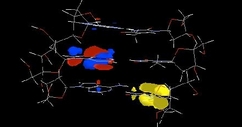Singlet electronic excitations of DNA duplex trimers and tetramers with regular homogeneous base-pair sequences ((dA)n(dT)n and (dG)n(dC)n, with n = 3, 4) have been investigated in vacuo using semiempirical quantum chemistry in a Zerner\u2019s Intermediate Neglect of Differential Overlap (ZINDO) approximation. Frequencies, oscillator strengths, and single-electron assignments of many-electron transitions have been calculated as functions of all 12 possible conformational modes of DNA duplexes. Specific DNA conformational modes responsible for significant changes in the exciton parentage (onset or arrest of the charge-transfer excitons\u2019 involvement into observable electronic transition spectra) are revealed. These computational results are thoroughly discussed in connection with numerous data of the most recent relevant experiments.

Singlet electronic excitations of DNA duplex trimers and tetramers with regular homogeneous base-pair sequences ((dA)n(dT)n and (dG)n(dC)n, with n = 3, 4) have been investigated in vacuo using semiempirical quantum chemistry in a Zerner\u2019s Intermediate Neglect of Differential Overlap (ZINDO) approximation. Frequencies, oscillator strengths, and single-electron assignments of many-electron transitions have been calculated as functions of all 12 possible conformational modes of DNA duplexes. Specific DNA conformational modes responsible for significant changes in the exciton parentage (onset or arrest of the charge-transfer excitons\u2019 involvement into observable electronic transition spectra) are revealed. These computational results are thoroughly discussed in connection with numerous data of the most recent relevant experiments.
